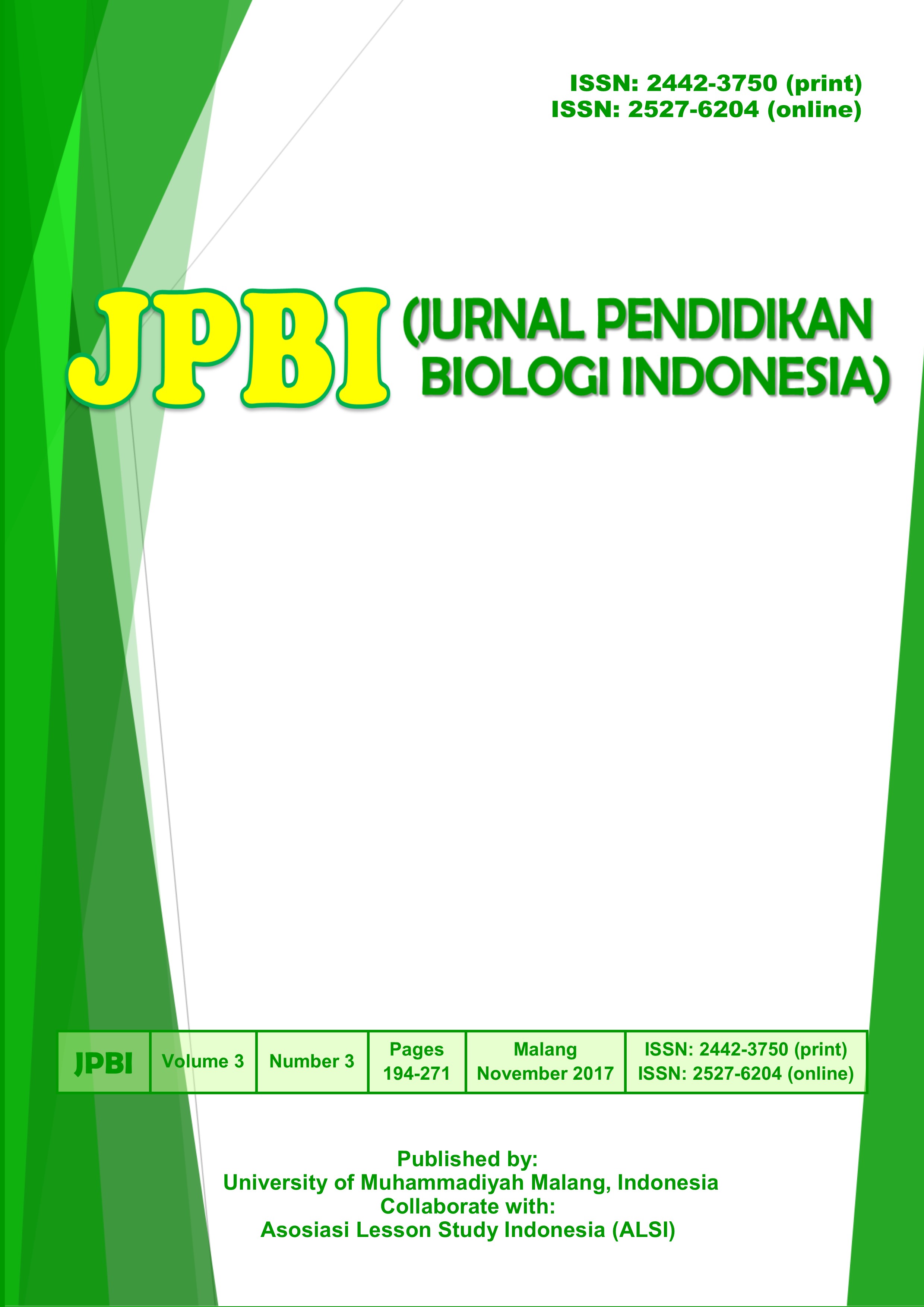The effect of problem solving learning model based just in time teaching (JiTT) on science process skills (SPS) on structure and function of plant tissue concept
DOI:
https://doi.org/10.22219/jpbi.v3i3.4502Keywords:
Just in time teaching, problem solving learning model, science process skillsAbstract
The purpose of this study was to determine the effect of Problem Solving learning model based Just in Time Teaching (JiTT) on students' science process skills (SPS) on structure and function of plant tissue concept. This research was conducted at State Senior High School in South Tangerang .The research conducted using the quasi-experimental with Nonequivalent pretest-Postest Control Group Design. The samples of this study were 34 students for experimental group and 34 students for the control group. Data was obtained using a process skill test instrument (essai type) that has been tested for its validity and reliability. Result of data analysis by ANACOVA, show that there were significant difference of postest between experiment and control group, by controlling the pretest score (F = 4.958; p <0.05). Thus, the problem-solving learning based on JiTT proved to improve students’ SPS. The contribution of this treatment in improving the students’ SPS was 7.2%. This shows that there was effect of problem solving model based JiTT on students’ SPS on the Structure and function of plant tissue concept.
Downloads
References
Fauzi, A., Corebima, A. D., & Zubaidah, S. (2016). The utilization of ferns as a model organism for studying natural polyploidization concept in genetics course. In International Conference on Education (pp. 51–58). Malang: Universitas Negeri Malang.
Haryono. (2006). Model pembelajaran berbasis peningkatan keterampilan proses sains. Jurnal Pendidikan Dasar, 7(1), 1–13.
Hasanah, H. D. (2014). Analisis keterampilan proses sains siswa kelas XI pada pembeajaran sistem laju reaksi menggunakan model problem solving. Universitas Islam Negeri Syarif Hidayatullah.
Husamah & Pantiwati, Y. (2014). Cooperative learning STAD-PjBL: Motivation, thinking skills, and learning outcomes in Biology Students. International Journal of Education Learning & Development (IJELD), 2(1), 77-94.
Junaedi, H. S., Supriadi, A. ., Mukhlison, & Mustamin. (2008). Strategi pembelajaran. Surabaya: Lapis-PGMI.
Mars, K. A., Blake, R. E., & Gavrin, A. D. (2003). Use Warm up exsercises in just in time teaching to determine students prior knowledge and misconseptions in biology, chemistry, and physics. US: Indianapolis.
Prawiradilaga, D. S., Ariani, D., & Handoko, H. (2013). Mozaik teknologi pendidikan e-learning. Jakarta: Kencana.
Solikhin, J. R. (2013). Model pembelajaran just in time teaching (JiTT) untuk meningkatkan keterampilan proses sains siswa SMP pada materi hukum newton. In Prosiding Seminar Nasional Sains dan Pendidikan Sains VIII. Salatiga: Fakultas Sains dan Matematika UKSW.
Sudarma, T. F. (2013). Efek model pembelajaran kooperatif tipe STAD berbasis just in time teaching terhadap hasil belajar fisika pada mata kuliah fisika sekolah di jurusan fisika FMIPA UNIMED. Jurnal Online Pendidikan Fisika, 2(1), 9–16.
Sugiyono. 2013. Metode penelitian kuantitatif kualitatif dan R & D. Bandung: Alfabeta.
Susilowati. (2013). Membelajarkan IPA dengan integrative science tinjauan scientific process skills dalam implementasinya pada kurikulum 2013. In Prhantoro (Ed.), Prosiding Seminar Nasional Penelitian, Pendidikan dan Penerapan MIPA (pp. 95–103). Yogyakarta: Fakultas MIPA UNY.
Zulfiani, Feronika, T., & Suartini, K. (2009). Strategi pembelajaran sains. Jakarta: LPU Jakarta.
Downloads
Published
Issue
Section
License
Authors who publish with JPBI (Jurnal Pendidikan Biologi Indonesia) agree to the following terms:
- For all articles published in JPBI, copyright is retained by the authors. Authors give permission to the publisher to announce the work with conditions. When the manuscript is accepted for publication, the authors agree to automatic transfer of the publishing right to the publisher.
- Authors retain copyright and grant the journal right of first publication with the work simultaneously licensed under a Creative Commons Attribution-ShareAlike 4.0 International License that allows others to share the work with an acknowledgment of the work's authorship and initial publication in this journal.
- Authors are able to enter into separate, additional contractual arrangements for the non-exclusive distribution of the journal's published version of the work (e.g., post it to an institutional repository or publish it in a book), with an acknowledgment of its initial publication in this journal.
- Authors are permitted and encouraged to post their work online (e.g., in institutional repositories or on their website) prior to and during the submission process, as it can lead to productive exchanges, as well as earlier and greater citation of published work (See The Effect of Open Access).

This work is licensed under a Creative Commons Attribution-ShareAlike 4.0 International License.


















